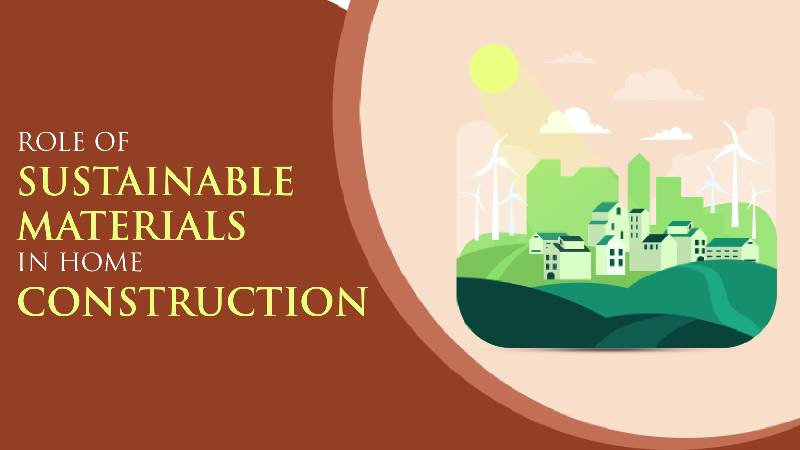Special Offers




Special Offers




13-Mar-2023 | Green Home

Sustainable materials are materials that are environmentally friendly and can be used in a way that conserves natural resources, reduces waste, and minimises harm to the environment. In home construction, sustainable materials play a vital role in ensuring that buildings are energy-efficient, cost-effective, and environmentally sustainable. You can get a Home Construction Loan from Aavas Financiers. Here are some details on the role of sustainable materials in home construction:
Sustainable materials such as high-performance insulation, energy-efficient windows, and doors can significantly reduce the amount of energy needed to heat and cool a home. This can help homeowners save money on their utility bills while also reducing their carbon footprint. High-performance insulation helps to keep heat inside during the winter and outside during the summer. This reduces the amount of energy needed to maintain a comfortable temperature inside the home, which translates into lower energy bills.
Additionally, using high-performance insulation can help to reduce the amount of carbon emissions produced by power plants that generate electricity used for heating and cooling. Energy-efficient windows and doors are designed to minimise heat transfer between the inside and outside of a home. They are usually made of materials that provide better insulation than traditional windows and doors, such as double or triple-pane glass, low-emissivity coatings, and insulated frames.
By using energy-efficient windows and doors, homeowners can reduce their energy consumption and save money on their utility bills. By making sustainable choices when it comes to building materials and home appliances, we can all do our part to create a more sustainable future.
Using sustainable building materials not only helps to reduce the environmental impact of construction but also provides economic benefits in the long run. Sustainable materials are chosen for their durability, energy efficiency, and eco-friendliness. Sustainable materials such as bamboo flooring, recycled-content metal roofing, and fibre-cement siding are more durable than traditional materials. This can reduce the need for replacement or repair and help reduce waste.
Durable flooring materials like bamboo and cork can last for many years and require less maintenance than other flooring options, while concrete flooring and walls, reclaimed wood, and metal roofing and siding are also excellent sustainable options. Concrete is durable and long-lasting, while reclaimed wood can add character and charm to a home. Metal roofing and siding are energy-efficient and can last for many years.
Recycling materials at the end of their life cycle is an important aspect of sustainable building practices. Materials like steel and concrete can be recycled, reducing the amount of waste that ends up in landfills and conserving natural resources. By using recycled materials like steel and concrete, we can create sustainable buildings that are both durable and eco-friendly.
In addition, recycled steel is just as strong and durable as new steel, making it an excellent sustainable building material. It helps to reduce waste, conserve natural resources, and reduce carbon emissions and energy consumption.
Sustainable materials such as low-flow showerheads, dual-flush toilets, and water-efficient faucets can help homeowners reduce their water consumption. This can help conserve water resources while also reducing water bills.
For example, a low-flow showerhead uses less water than a traditional shower head while still providing a satisfying shower experience. Dual-flush toilets allow users to choose between a lower and higher volume of water for flushing, depending on the type of waste being flushed, while water-efficient faucets reduce the flow of water while still providing adequate pressure for washing hands or doing dishes.
By implementing these sustainable materials in your home, you can significantly reduce your household's water consumption, which not only helps conserve water resources but can also lead to lower water bills. Moreover, reducing water usage helps to lower the energy required to pump and treat water, which can contribute to overall energy conservation efforts.
Sustainable materials such as wood, cork, and bamboo are renewable materials that can be harvested without depleting natural resources. These materials have a much lower environmental impact and can help reduce the carbon footprint of home construction. Wood, for example, is a popular sustainable material for construction because it is renewable and when harvested responsibly, forests can actually act as a carbon sink, absorbing carbon dioxide from the atmosphere and storing it in the wood. Additionally, wood is biodegradable and can be recycled or repurposed, reducing waste in landfills.
Cork is another sustainable material that can be harvested without harming the cork oak tree. The outer bark of the tree can be harvested every 9-10 years, which allows the tree to continue growing and producing more cork. Cork is a highly insulating material and is commonly used in flooring and wall tiles. Bamboo is a fast-growing, renewable material that can be harvested every 3-5 years. It is incredibly strong and durable and can be used in a variety of applications, including flooring, furniture, and structural elements.
Using sustainable materials like these can help reduce the carbon footprint of home construction and make the building process more environmentally friendly. Additionally, these materials often have a natural, warm aesthetic that can add character and charm to a home.
Sustainable materials such as natural paints, low-VOC (volatile organic compounds) carpets, and flooring can indeed improve indoor air quality and help reduce the risk of health problems such as asthma and other respiratory illnesses.
Volatile organic compounds (VOCs) are chemicals that can be released into the air from various sources, including paints, carpets, and flooring materials. Exposure to high levels of VOCs can cause eye, nose, and throat irritation, headaches, dizziness, and other health problems. Long-term exposure to VOCs has also been linked to an increased risk of cancer and other serious health problems. Whereas, natural paints, low-VOC carpets, and flooring materials can help reduce indoor air pollution by minimising the release of VOCs. These sustainable materials are typically made from natural or recycled materials that do not contain harmful chemicals or toxins.
Using sustainable materials in building and home renovation projects can have significant benefits for both the environment and human health. By reducing exposure to harmful chemicals and pollutants, we can create healthier indoor environments and reduce the risk of health problems caused by indoor air pollution.
Sustainable materials sourced locally not only support the local economy but also helps to reduce the carbon footprint associated with the transportation of goods over long distances. When products are shipped globally, they require significant amounts of energy to be transported, packaged, and stored, which can contribute to greenhouse gas emissions and environmental degradation.
By buying sustainable materials sourced locally, you are also promoting sustainable practices such as reducing waste, conserving natural resources, and supporting small businesses. Sustainable materials sourced locally can reduce transportation costs and carbon emissions associated with shipping materials over long distances.
By increasing the efficiency of operation, choosing technologies that help in waste reduction, and optimising supplies and materials of construction, we can reduce the waste generated during the process of construction. Also, construction-related waste must be treated properly so that it does not unnecessarily pile up and pollute water bodies.
In conclusion, the use of sustainable materials in home construction plays a vital role in reducing the environmental impact of buildings while also providing homeowners with energy-efficient, cost-effective, and durable homes. The benefits of sustainable materials are not limited to the environment, but also extend to improving indoor air quality, reducing water consumption, and supporting local economies. By using sustainable building materials and practices, we can create homes that are not only environmentally friendly but also cost-efficient and long-lasting. It's a win-win for both the planet and our wallets!